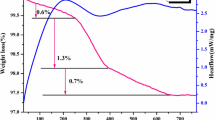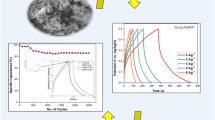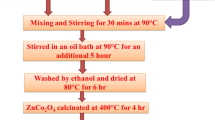Abstract
Transition metal oxide–based pseudocapacitors with various valence states are of particular interest in the field of energy storage due to their increased specific capacitance values. In particular, Copper cobaltite nanomaterials have attracted more research focus due to their multiple oxidation states in comparison to other transition metals. Spinel structures of metal oxides are of tremendous interest for energy storage applications. Mixed valence metal cations in spinel cobaltites (MCo2O4) offer more electronic conductivity and electrochemical activity than single–component oxides. Natural abundance, good electrical and thermal stability, environment–friendly nature, and low cost motivates researchers for carrying out an extensive study of such materials. In this study, binary composite CuCo2O4@Co3O4 was synthesized by facile hydrothermal method. FT–IR, XRD, FEG–SEM and XPS studies have established the successful formation of all the nanocomposites were used to primarily characterize the sample. XRD showed the existence of all the synthesized materials in crystalline form. Cyclic voltammetry (CV), Galvanostatic Charge–Discharge (GCD) and Electrochemical Impedance (EIS) measurements were recorded to examine the electrochemical characteristics. The comparative specific capacitance of the synthesized CuCo2O4@Co3O4 nanocomposite displayed 542.77 Fg−1 using Glassy Carbon (GCE) as the working electrode whereas it exhibited 683.72 Fg−1 at the same current density of 1 Ag−1 using Nickel foam as the electrode substrate. The composite electrode exhibited an excellent pseudocapacitive behaviour using 1 M Na2SO4 and 1 M KOH as electrolytes respectively for electrochemical measurements. Impedance analysis reveals capacitive nature of the synthesized materials. Furthermore, cyclic stability for CuCo2O4@Co3O4 nanocomposite was found to be 76% (GCE) upto 1000 cycles at 5 Ag−1 and 78% (Nickel foam) upto 3000 cycles at 5 Ag−1. Based on the study of the electrochemical performance, the synthesized transition metal oxide nanocomposite holds potency as an efficient electrode material for energy storage applications.
Graphical abstract











Similar content being viewed by others
References
Zhong Y, Xia X, Mai W, Tu J, Fan HJ (2017) Integration of energy harvesting and electrochemical storage devices. Adv Mater Technol 2:1–14. https://doi.org/10.1002/admt.201700182
Krishnan SG, Reddy M, Harilal M, Vidyadharan B, Jose R (2015) Characterization of MgCo2O4 as an electrode for high performance supercapacitors. Electrochim Acta 161:312–321. https://doi.org/10.1016/j.electacta.2015.02.081
Chen Hu, Xuming Du, Runze Wu, Ya W, Sun J, Zhang Y, Chunju Xu (2023) Facile hydrothermal synthesis of porous MgCo2O4 nanoflakes as electrode material for high–performance asymmetric supercapacitors. Nanoscale Adv. https://doi.org/10.1039/D3NA00462G
Shanmugavalli V, Vishista K (2020) An investigation on the supercapacitive performance of CuCo2O4/Polyaniline, a nanocomposite of spinel structured transition binary metal oxide and conducting polymer, with a special focus on bonding and electron density distribution through MEM. J Inorg Organomet Polym Mater 30:1448–1462. https://doi.org/10.1007/s10904-019-01268-z
Dakshayini BS, Reddy KR, Mishra A, Shetti NP, Malode SJ, Basu S, Naveen S, Raghu Anjanapura V (2019) Role of conducting polymer and metal oxide–based hybrids for applications in amperometric sensors and biosensors. Microchem J 147:7–24. https://doi.org/10.1016/j.microc.2019.02.061
Duan L, Gao F, Wang L, Jin S, Wu H (2013) Hydrothermal synthesis and characterization of MnCo2O4 in the low-temperature hydrothermal process: Their magnetism and electrochemical properties. J Adv Ceram 2:266–273. https://doi.org/10.1007/S40145-013-0070-0
Li Y, Hou X, Li Y, Qiang Ru, Shaofeng WH, Shejun L, Kwok-Ho, (2017) Facile synthesis of hierarchical CoMn2O4 microspheres with porous and micro-nanostructural morphology as anode electrodes for lithium-ion batteries. Electron Mater Lett 13:427–433. https://doi.org/10.1007/s13391-017-6258-7
Li J, Xiong S, Li X, Qian Y (2013) A facile route to synthesize multiporous MnCo2O4 and CoMn2O4 spinel quasi-hollow spheres with improved lithium storage properties. Nanoscale 5:2045–2054. https://doi.org/10.1039/C2NR33576J
Silambarasan M, Padmanathan N, Ramesh PS, Geetha D (2016) Spinel CuCo2O4 Nanoparticles: facile one-step synthesis, optical, and electrochemical properties. Mater Res Express 3:1–10. https://doi.org/10.1088/2053-1591/3/9/095021
Wang Q, Xu J, Wang X (2014) Core-Shell CuCo2O4@MnO2 Nanowires on carbon fabrics as high-performance materials for flexible, all–solid–state, electrochemical capacitors. Chem Electro Chem 1:559–564. https://doi.org/10.1002/CELC.201300084
Pendashteh A, Moosavifard Seyyed E, Rahmanifar Mohammad S, Yue W (2015) Highly ordered mesoporous CuCo2O4 nanowires, a promising solution for high-performance supercapacitors. Chem Mater 27:3919–3926. https://doi.org/10.1021/acs.chemmater.5b00706
Jang GS, Ameen S, Akhtar MS, Kim E, Shin HS (2017) Electrochemical investigations of hydrothermally synthesized porous cobalt oxide (Co3O4) nanorods: supercapacitor application. ChemistrySelect 2:8941–8949. https://doi.org/10.1002/slct.201701571
Hasan I, Alharthi FA (2023) Synthesis of Cobalt Oxide (Co3O4) Nanoparticles for efficient photocatalytic water splitting and hydrogen production. ChemistrySelect 8:202302685. https://doi.org/10.1002/SLCT.202302685
Wang Q, Jiang M, Zhang L (2021) Label–free and visible–light driven photoelectrochemical sensor with CuCo2O4@CoO Core-shell hybrid rod as photoanode for selective sensing diclofenac. Electrochim Acta 397:139239. https://doi.org/10.1016/j.electacta.2021.139239
Jiang F, Su Q, Li H, Yao L, Deng H, Du G (2017) Growth of ultrafine CuCo2O4 nanoparticle on graphene with enhanced lithium storage properties. J Chem Eng 314:301–310. https://doi.org/10.1016/J.CEJ.2016.11.064
Das D, Jyoti SB (2022) Synthesis, characterization and biological applications of cobalt oxide (Co3O4) nanoparticles. Chem Phys Impact 6:1–3. https://doi.org/10.1016/j.chphi.2022.100137
Sivashanmugam G, Lakshmi K, Preethi B, Nelson S, Sathiyaseelan M (2021) CTAB-templated formation of CuCo2O4/CuO nanorods and nanosheets for high-performance supercapacitor applications. J Mater Sci Mater Electron 32:27148–27158. https://doi.org/10.1007/S10854-021-06845-Y
Patil KN, Prasad D, Bhanushali D, Kim JT, Atar H, Nagaraja AB, Jadhav BM (2020) Sustainable hydrogen generation by catalytic hydrolysis of NaBH4 using tailored nanostructured urchin-like CuCo2O4 spinel catalyst. Catal Letters 150:586–604. https://doi.org/10.1007/S10562-019-03025-W
Huerta F, Cazorla–amor D, Morall E, (2019) Copper-doped cobalt spinel electrocatalysts evolution reaction. Materials 12:1302. https://doi.org/10.3390/ma12081302
Kaverlavani SK, Moosavifard SE, Bakouei A (2017) Designing graphene-wrapped nanoporous CuCo2O4 hollow spheres electrodes for high-performance asymmetric supercapacitors. J Mater Chem A Mater 5:14301–14309. https://doi.org/10.1039/c7ta03943c
Chen X, Zhu J, Ding Y, Zuo X (2021) Synthesis of CuCo2O4 nanoparticles as an anode material with high performance for lithium–ion batteries. J Mater Sci Mater Electron 32:18765–18776. https://doi.org/10.1007/s10854-021-06395-3
Chen H, Liu Y, Sun J, Xu C (2021) High–performance hybrid supercapacitor based on the porous copper cobaltite/cupric oxide nanosheets as a battery–type positive electrode material. Int J Hydrog Energy 46:28144–28155. https://doi.org/10.1016/j.ijhydene.2021.06.056
Mahala C, Basu M (2017) Nanosheets of NiCo2O4/NiO as efficient and stable electrocatalyst for oxygen evolution reaction. ACS Omega 2:7559–7567. https://doi.org/10.1021/acsomega.7b00957
Al JBA, Abu-Rayyan A, Taher MM, Shoueir K (2022) Photosynthesis of Co3O4 nanoparticles as the high energy storage material of an activated carbon/Co3O4 symmetric supercapacitor device with excellent cyclic stability based on a Na2SO4 aqueous electrolyte. ACS Omega 7:23673–23684. https://doi.org/10.1021/acsomega.2c02305
Qi J, Chen D, Wang W, Sui Y, He Y (2019) Facile synthesis of N–doped activated carbon derived from cotton and CuCo2O4 nanoneedle arrays electrodes for all-solid-state asymmetric supercapacitor. J Mater Chem A Mater 30:9877–9887. https://doi.org/10.1007/s10854-019-01325-w
Javed MS, Dai S, Wang M, Yi Xi (2015) Faradic redox active material of Cu7S4 nanowires with a high conductance for flexible solid–state supercapacitors. Nanoscale 7:13610–13618. https://doi.org/10.1039/C5NR03363B
Zhang Y, Hu Y, Wang Z, Lin T, Xi Z (2020) Lithiation-induced vacancy engineering of Co3O4 with improved faradic reactivity for high-performance supercapacitor. Adv Funct Mater 30:2004172. https://doi.org/10.1002/adfm.202004172
Nawaz B, Ullah MO, Ali G (2014) An investigation of the electrochemical properties of CuCo2O4@NiCo2O4 composite as binder-free electrodes of a supercapacitor. Energies (Basel) 14:3237. https://doi.org/10.3390/en14113237
Wang X, Ding H, Luo Wei Yu, Yi CQ, LuO B, Xie M, Guo X (2023) Morphology evolution of CoNi-LDHs synergistically engineered by precipitant and variable cobalt for asymmetric supercapacitor with superior cycling stability. EcoEnergy 1:448–459. https://doi.org/10.1002/ece2.21
Chang K, Zhang P, Chen X (2024) Research on modification and electrochemical properties of zinc-doped spherical CuO nanomaterials. J Solid State Electrochem. https://doi.org/10.1007/s10008-023-05796-0
Yumeng L, Li Li, Liangliang Z, Gengxu H, Liu Z, Jiaxing H, Zhu Z, Qiao ZA (2023) Emulsion-assisted interfacial polymerization strategy: controllable architectural engineering of anisotropic and isotropic nanoparticles for high-performance supercapacitors. Battery Energy 2:20220058. https://doi.org/10.1002/bte2.20220058
Qui K, Lu Y, Cheng J, Yan H, LuO Y (2015) Ultrathin mesoporous Co3O4 nanosheets on Ni foam for high—performance supercapacitors. Electrochim Acta 157:62–68. https://doi.org/10.1016/j.electacta.2014.12.035
Gao Q, Wang J, Wang J (2019) Morphology-controllable synthesis of CuCo2O4 arrays on Ni foam as advanced electrodes for supercapacitors. J Alloys Compd 789:193–200. https://doi.org/10.1016/j.jallcom.2019.03.041
Franklin J, Sachin S, Sundaram S, Anand G, Raj A, Kaviyarasu K (2019) Investigation on copper cobaltite (CuCo2O4) and its composite with activated carbon (AC) for supercapacitor applications. Mater Sci Energy Technol 7:91–98. https://doi.org/10.1016/j.mset.2023.07.006
Madhu R, Veeramani V, Shen C, Manikandan A, An-Ya Lo, Chueh Yu (2015) Honeycomb-like porous carbon-cobalt oxide nanocomposite for high-performance enzymeless glucose sensor and supercapacitor applications. ACS Appl Mater Interfaces 7:15812–15820. https://doi.org/10.1021/acsami.5b04132
Wang X, Yin S, Jiang J, Xiao H, Li X (2020) A tightly packed Co3O4/C&S composite for high-performance electrochemical supercapacitors from a cobalt (III) cluster-based coordination precursor. J Solid State Electrochem. https://doi.org/10.1016/j.jssc.2020.121435
Acknowledgements
The authors greatly thank Micro–Analytical Laboratory, Department of Chemistry, University of Mumbai for providing Instrumental facilities. The authors also thank IIT Bombay for providing XRD, XPS measurements and SEM analysis. One author, Bhakti G. Thali, is grateful to Savitribai Jyotirao Phule Single Girl Child Fellowship (SJSGC) UGC, Delhi, India for JRF.
Author information
Authors and Affiliations
Contributions
Bhakti G. Thali: Methodology, Formal analysis, Investigation, Writing–original draft. Prof. Rajesh M. Kamble: Conceptualization, Investigation, Visualization, Resources, Supervision, Writing–Review and Editing.
Corresponding author
Ethics declarations
Conflict of interest
The authors declare no conflict of interest.
Additional information
Publisher's Note
Springer Nature remains neutral with regard to jurisdictional claims in published maps and institutional affiliations.
Highlights
• Binary composite CuCo2O4@Co3O4 has been synthesized by hydrothermal method.
• CuCo2O4@Co3O4 nanocomposite displayed specific capacitance 542.77 Fg−1 using GCE and 683.72 Fg−1 using Nickel Foam at the current density of 1 Ag−1.
• CuCo2O4@Co3O4 nanocomposite exhibited 78% (Nickel Foam) and 76% (GCE) capacitive retention respectively up to 3000 and 1000 cycles at the current density of 5 Ag−1.
Rights and permissions
Springer Nature or its licensor (e.g. a society or other partner) holds exclusive rights to this article under a publishing agreement with the author(s) or other rightsholder(s); author self-archiving of the accepted manuscript version of this article is solely governed by the terms of such publishing agreement and applicable law.
About this article
Cite this article
Thali, B.G., Kamble, R.M. Synthesis and electrochemical properties of CuCo2O4@Co3O4 nanocomposite for supercapacitor application. J Solid State Electrochem (2024). https://doi.org/10.1007/s10008-024-05909-3
Received:
Revised:
Accepted:
Published:
DOI: https://doi.org/10.1007/s10008-024-05909-3




